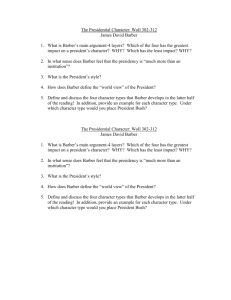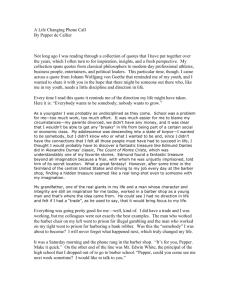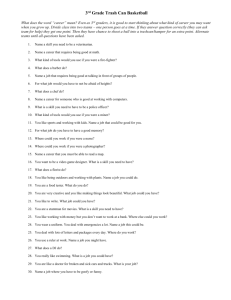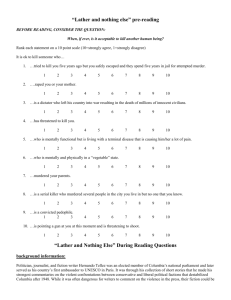Sample Essay
advertisement
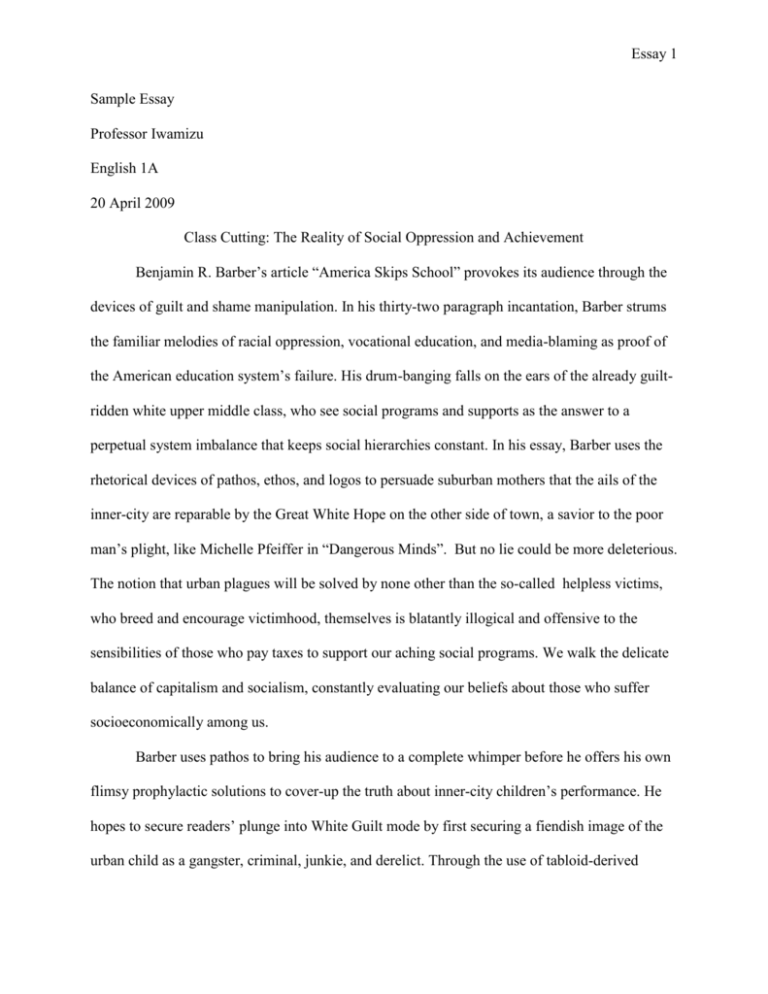
Essay 1 Sample Essay Professor Iwamizu English 1A 20 April 2009 Class Cutting: The Reality of Social Oppression and Achievement Benjamin R. Barber’s article “America Skips School” provokes its audience through the devices of guilt and shame manipulation. In his thirty-two paragraph incantation, Barber strums the familiar melodies of racial oppression, vocational education, and media-blaming as proof of the American education system’s failure. His drum-banging falls on the ears of the already guiltridden white upper middle class, who see social programs and supports as the answer to a perpetual system imbalance that keeps social hierarchies constant. In his essay, Barber uses the rhetorical devices of pathos, ethos, and logos to persuade suburban mothers that the ails of the inner-city are reparable by the Great White Hope on the other side of town, a savior to the poor man’s plight, like Michelle Pfeiffer in “Dangerous Minds”. But no lie could be more deleterious. The notion that urban plagues will be solved by none other than the so-called helpless victims, who breed and encourage victimhood, themselves is blatantly illogical and offensive to the sensibilities of those who pay taxes to support our aching social programs. We walk the delicate balance of capitalism and socialism, constantly evaluating our beliefs about those who suffer socioeconomically among us. Barber uses pathos to bring his audience to a complete whimper before he offers his own flimsy prophylactic solutions to cover-up the truth about inner-city children’s performance. He hopes to secure readers’ plunge into White Guilt mode by first securing a fiendish image of the urban child as a gangster, criminal, junkie, and derelict. Through the use of tabloid-derived Essay 2 statistics, Barber frets us into believing me that “gangs in the schoolyard, drugs in the classroom, children doing babies instead of homework, [and] playground firefights featuring Uzis and Glocks” (par. 3) are the norm for urban schools. A mere flit of one’s eyes in the direction of an inner-city public school will return, according to Barber, a mouth-gaping scenario of a desperate wasteland. This image of impending doom cements the confused fear, anguish, and concern to which those struggling from White Guilt succumb. Moreover, Barber stirs the ever-brewing pot of racial tension by playing the overplayed and antiquated “race card”. He brings down the gavel on compassionate conservatism by immediately identifying the room’s proverbial elephant. He warns, “A lot of the dropouts will end up in prison, which is a surer bet for young black males than college: one in four will pass through the correctional system, and at least two out of those will be dropouts” (par. 2). And the audience heaves a collective shriek, shaking their heads in disdain and pity for the helplessly frail black male victim. While this strategy certainly panders to Barber’s audience, it further cripples the already victimized black male who craves uplifting, not sympathetic votes, policies, and programs in his disfavor. Once in full stride, at the height of his essay, Barber saddles the heavy burden of shame onto his audience further by concluding about “our” (or White) young adults will “write off school” and “probably write off blacks as well” “[i]f they observe their government spending up to $35,000 a year to keep a young black behind bars but a fraction of that to keep him in school” (par. 12). This strikes at the very moral fiber of the reader, who spent the “licentious Sixties” championing Civil Rights and diversity only to have her convictions erode once she is now an “aging hipp[y]” (par. 7). Securing his reader’s emotional incapacity to discern truth from fabrication, Barber furthers his Democrat agenda by providing a flawed portrait of his own credibility. Essay 3 Barber’s attempts at ethos codify the obtuseness with which Barber presents his shortcomings, or arguments. He begins providing his credentials by rattling off bemusing abstractions, like “I have spent thirty years as a scholar examining the nature of democracy, and even more as a citizen optimistically celebrating its possibilities” (par. 6). Of course, neither Barber’s survey nor his enthusiasm amount to a substantial degree to support his grandiose claims. Along with his feel-good references to Tocqueville, Rousseau, and Voltaire, Barber grandstands the liberal arts training he has and the vocabulary with which it affords him. He uses terms like “pedagogues”, “nihilistic”, and “captious” to display his verbal range in full color while wowing his audience much like a magical illusion tricks a group of impressionable fiveyear-olds. These larger-than-life statements make Barber like a grand puba before his now practically bumbling readership. “How this captious literature reeks of hypocrisy!” (par. 8) he exclaims with all the full patriarchal authority of someone with a thirty-year history of waxing poetic about democracy. Not only does Barber establish his credibility through the use of dissertation jargon, he also flashes around trumped-up statistics that have all the flair of a fake Rolex watch. Finally, Barber utilizes logos in his desperate attempts to woo and convict his audience simultaneously. His statistics are never supportive; they are snippets of veracity that conglomerate into Barber’s web of fantasy. In the very opening of his essay, Barber tosses nuggets of truth, couched in statistical formulas, to shock his unsuspecting readers. “Fewer than 20 percent of those surveyed could compare two metaphors in a poem” (par. 1) is the claim meant to outrage the undiscriminating reader. Never mind the fact that poetic analysis is hardly a job or career skill; even less is it a rite of passage for citizens to master poetic metaphor. And the questions arising about a society that focuses more on metaphor than reality fail to surface for the Essay 4 reader/victim. Becoming deeper indoctrinated into Barber’s illegitimate claims, the reader is fed a paradox cloaked in data, meant to dupe the reader into holding conflicting ideas. He asserts, “teachers make less than accountants, architects, doctors, lawyers, engineers, judges, health professionals, auditors, and surveyors,” a claim which—upon hearing—is supposed to arouse automatic mob-think. Then, in juxtaposition, he offers, “American children are in school only about 180 days a year, as against 240 days or more for children in Europe or Japan” (par. 3), which falls in perfect contrast to the aforementioned career professionals, many of whom work seventy plus hours weekly and fifty weeks annually. No one dares to ask if it’s even logical for teachers who work 180 days out of a 260-day potential work year to make the same as doctors or lawyers. But this habit of accepting disfigured and irrelevant facts is not beyond Barber’s optimistically liberal audience. He easily scapegoats everyone but the real culprit yet again when he begins lambasting the media. He takes from Lifetime Learning Systems the sound byte that “’kids spend 40 percent of each day” at school; it is Barber, though, who presumes that the corporation owns the rest of the child’s mind. And at 60%, the default rate at which his readers would arrive based upon Barber’s piece-meal claim, the reader is sent into full outrage at the notion that his/her children (and let’s not forget those poor, despairing ghetto kids) are owned by the media, fed its ideals more than they are spooned the ideals of liberal socialism.

